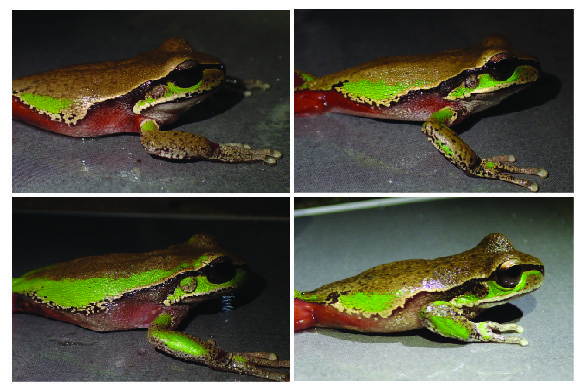Smile for the Camera! Frog mug shots help track the health of frog populations
Can we identify individual frogs from photos of their body patterns? A recently published study has confirmed we can for the Blue Mountains Tree Frog!
We all have defining features that make us unique and distinguishable from other people, whether these are genetic differences such as eye colour or freckle patterns, or more acquired traits such as scars or tattoos. This is also the case with many animal species, even those that look identical at first glance!
Scientists have been observing physical differences to identify individual animals using a technique called the photo identification method (PIM) for years. Animals that have been successfully identified based upon their appearance range from dolphins, whales, zebras, and even badgers. In more recent years, this technique has been applied to reptiles and amphibians, successfully identifying individual sea turtles, salamanders, lizards and frogs.

The Blue Mountains Tree Frog (Litoria citropa).
Image: Jodi Rowley© Jodi Rowley
During a study on the presence and intensity of the amphibian chytrid fungus (Chytridiomycosis) in a Sydney population of the stunning Blue Mountains Tree Frog (Litoria citropa) (more on the original study here), I noticed and was subsequently in awe of the distinctive markings on this species’ body. I decided to investigate the ability to use these markings to distinguish individuals from one another, through photo identification.

Variation in body patterning in the Blue Mountains Tree Frog (Litoria citropa).
Image: Jordann Crawford-Ash© Jordann Crawford-Ash
During our field surveys, we took photos of the front, sides and top of each Blue Mountains Tree Frog encountered across an 8 month period. We then examined these images and visually matched the black head and body markings of each frog to see if we encountered any of these frogs multiple times … and we did! We were able to match two individuals visually, encountering one individual again after 88 days and another 45 days later. We then checked our findings using a pattern matching software called HotSpotter. Using both methods, we were able to re-match the same two individuals.

The same individual Blue Mountains Tree Frog (Litoria citropa) after 88 days, identified by its unique markings.
Image: Jordann Crawford-Ash© Jordann Crawford-Ash
The ability to match individuals using their body patterning is great news – this allows us to track frog populations and study how they progress over time without using other identification methods such as tagging, which can be expensive and time consuming. Photo identification requires only a camera! Also, this method may assist in gaining a more holistic view to a frog’s life, such as their life span, how far they travel, and how it may be coping with disease.
Further studies are needed to understand the role of photo identification for Australia’s frogs. For now, our catalogue of mug shots is a small but important advance in our toolkit, that may be particularly useful in monitoring and conserving threatened species in the future.
Jordann Crawford-Ash, Research Assistant & FrogID Validator, Herpetology, Australian Museum Research Institute.
More information
Crawford-Ash, J. & Rowley, J. J. L (2021). Photo identification of individual Blue Mountains Tree Frogs, Herpetology Notes, 14: 803-808. https://www.biotaxa.org/hn/article/view/61640

